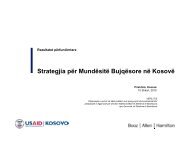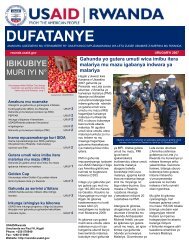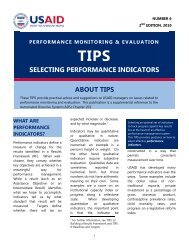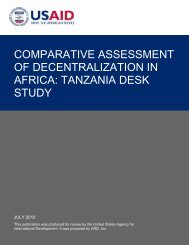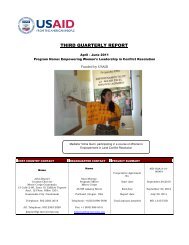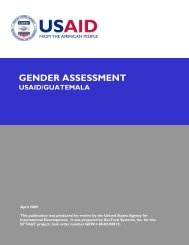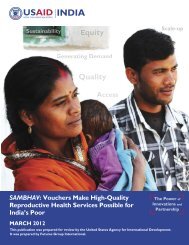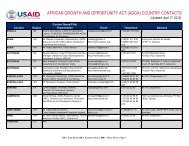Users Guide to USAID/Washington Health Programs
Users Guide to USAID/Washington Health Programs
Users Guide to USAID/Washington Health Programs
Create successful ePaper yourself
Turn your PDF publications into a flip-book with our unique Google optimized e-Paper software.
Introduction <strong>to</strong> <strong>USAID</strong><br />
Working in Partnership <strong>to</strong> Achieve Shared <strong>Health</strong> Goals<br />
The development landscape has evolved dramatically over the last two decades. The clearest sign of<br />
this evolution is the sheer number of development ac<strong>to</strong>rs; as of 2011, there were 263 multilateral<br />
agencies and 197 bilateral agencies through which official government development assistance flows.<br />
Assistance from “emerging donor” nations such as China, India, Brazil, and the Gulf states is growing rapidly.<br />
This is all in addition <strong>to</strong> the thousands of non-governmental organizations both for-profit and<br />
not-for-profit private corporations, private foundations, local businesses, and other organizations working in<br />
the developing world.<br />
The policy context for <strong>USAID</strong> partnering is global and embraces principles expressed in the Paris Declaration<br />
for Aid Effectiveness and the Accra Agenda for Action; it is national as set forth in the Presidential<br />
Policy Directive on Global Development and the Quadrennial Diplomacy and Development Review<br />
(QDDR); it is <strong>USAID</strong>-wide as set forth in the <strong>USAID</strong> Policy Framework and <strong>USAID</strong> Forward; and finally<br />
it is health specific in that it embraces the GHI Principles.<br />
<strong>USAID</strong>’s Bureau for Global <strong>Health</strong> engages with a multitude of development partners – in the public sec<strong>to</strong>r<br />
this includes other bilateral donor governments, multilateral government entities, international financial institutions,<br />
other USG agencies, United Nations organizations, and host country governments themselves. In<br />
the private sec<strong>to</strong>r, our partners include foundations, corporations, contrac<strong>to</strong>rs, universities, and a variety of<br />
non-governmental organizations large and small, global and local, including those whose members are from<br />
both public and private sec<strong>to</strong>rs including Global Alliance for Vaccines and Immunization (GAVI), Global<br />
Alliance for Improved Nutrition (GAIN), International AIDS Vaccine Initiative (IAVI), Roll Back Malaria<br />
(RBM), S<strong>to</strong>p TB Partnership (STOP TB), Reproductive <strong>Health</strong> Supplies Coalition (RHSC), Reproductive<br />
Maternal and Newborn <strong>Health</strong> (RMNH), and Partnership for Maternal Newborn and Child <strong>Health</strong><br />
(PMNCH) among others.<br />
Through partnering, we leverage the resources of others, be they financial, technical/programmatic, or political.<br />
We coordinate with other partners because we believe that by acting <strong>to</strong>gether we can achieve more<br />
than each of us can operating independently. We coordinate with others because we hope <strong>to</strong> achieve:<br />
• Increased effectiveness of health aid/programming<br />
• Increased efficiency of health aid/programming<br />
• Increased scalability of priority health interventions<br />
• Increased ownership by host country governments (sustainability)<br />
Roles for the Bureau for Global <strong>Health</strong>: The funds allocated <strong>to</strong> the Bureau for Global <strong>Health</strong> address<br />
the same Agency goals and objectives as Mission funds, but are used in ways appropriate for a central,<br />
functional bureau. These uses include:<br />
• Providing technical leadership in responding <strong>to</strong> new global health challenges<br />
• Partnering strategically with a wide range of ac<strong>to</strong>rs<br />
• Accelerating the development and application of innovation, science, and technology<br />
• Scaling up evidence-based, equitable, and locally-adapted health solutions<br />
• Strengthening local health system capacity <strong>to</strong> support partner countries’ leadership of health policies,<br />
strategies, and actions<br />
• Promoting gender equality and female empowerment<br />
• Working efficiently and being effective stewards of public trust and resources<br />
-4-



